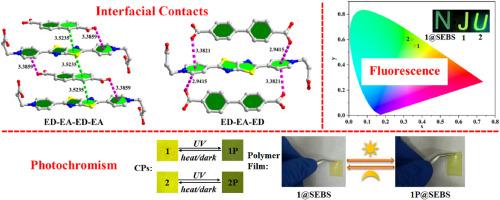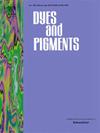Photochromic and photo-regulated fluorescent coordination polymers derived from thiazolothiazole extended viologen in solid state and polymer film
IF 4.1
3区 工程技术
Q2 CHEMISTRY, APPLIED
引用次数: 0
Abstract
In this study, we addressed the efforts of controlling the structures of coordination polymers (CPs) for enhanced photochromism by modulating interactions between electron donors (EDs) and acceptors (EAs) or boosting EAs' electron affinity. Two new CPs, [Cd (TTVP)0.5 (2,6-NDC) (H2O)]·0.5DMF (1) and [Cd (TTVP)0.5 (4,4′-BPC) (H2O)2]·0.5H2O (2) have been successfully synthesized using the thiazolothiazole extended viologen ligand TTVP (TTVP = 2,5-bis(pyridinium-4-yl)thiazolo [5,4-d]thiazole propionate) as an EA and different aromatic carboxylic acids as EDs. Complex 1 features a 3D supramolecular structure with interpenetrating layers with n-π and π-π interactions, while complex 2 adopts a 2D structure with layer stacking through n-π interactions. Both CPs exhibit notable photochromism via photo-introduced electron transfer (PIET) process, with different ED/EA arrangements (ED-EA-ED-EA for 1 and ED-EA-ED for 2) affecting their photoresponse. UV irradiation reveals varying photochromic response rates and color contrasts in the two CPs, highlighting EDs' influential role. Furthermore, both CPs showed a synergistic response of photochromism and photo-controlled fluorescence. Notably, a composite polymer film with reversible photochromic and photo-controlled fluorescence behaviors was fabricated by integrating compound 1 into a styrene ethylene butylene styrene (SEBS) matrix. This study presents a new approach for improving the performance of photochromic materials with potential applications in daily life.

固态和聚合物薄膜中由噻唑噻二唑延伸紫胶衍生的光致变色和光调节荧光配位聚合物
在本研究中,我们致力于通过调节电子供体(ED)和受体(EAs)之间的相互作用或提高 EAs 的电子亲和力来控制配位聚合物(CPs)的结构,从而增强光致变色作用。两种新的 CPs,[Cd (TTVP)0.5 (2,6-NDC) (H2O)]-0.5DMF (1) 和 [Cd (TTVP)0.5 (4,4′-BPC) (H2O)2]-0.5H2O (2),它们是以噻唑噻唑扩展紫胶配体 TTVP(TTVP = 2,5-双(吡啶-4-基)噻唑并[5,4-d]噻唑丙酸酯)为 EA,以不同的芳香族羧酸为 ED 成功合成的。复合物 1 具有三维超分子结构,各层通过 n-π 和 π-π 相互作用相互渗透,而复合物 2 则采用二维结构,各层通过 n-π 相互作用堆叠。两种氯化石蜡都通过光诱导电子转移(PIET)过程表现出显著的光致变色性,不同的 ED/EA 排列(1 的 ED-EA-ED-EA 和 2 的 ED-EA-ED)会影响它们的光响应。在紫外线照射下,两种氯化石蜡的光致变色反应速率和颜色对比各不相同,凸显了 ED 的影响作用。此外,两种氯化石蜡都显示出了光致变色和光控荧光的协同反应。值得注意的是,通过将化合物 1 与苯乙烯-乙烯-丁烯-苯乙烯(SEBS)基质结合,制备出了一种具有可逆光致变色和光控荧光行为的复合聚合物薄膜。这项研究为提高光致变色材料的性能提供了一种新方法,有望应用于日常生活中。
本文章由计算机程序翻译,如有差异,请以英文原文为准。
求助全文
约1分钟内获得全文
求助全文
来源期刊

Dyes and Pigments
工程技术-材料科学:纺织
CiteScore
8.20
自引率
13.30%
发文量
933
审稿时长
33 days
期刊介绍:
Dyes and Pigments covers the scientific and technical aspects of the chemistry and physics of dyes, pigments and their intermediates. Emphasis is placed on the properties of the colouring matters themselves rather than on their applications or the system in which they may be applied.
Thus the journal accepts research and review papers on the synthesis of dyes, pigments and intermediates, their physical or chemical properties, e.g. spectroscopic, surface, solution or solid state characteristics, the physical aspects of their preparation, e.g. precipitation, nucleation and growth, crystal formation, liquid crystalline characteristics, their photochemical, ecological or biological properties and the relationship between colour and chemical constitution. However, papers are considered which deal with the more fundamental aspects of colourant application and of the interactions of colourants with substrates or media.
The journal will interest a wide variety of workers in a range of disciplines whose work involves dyes, pigments and their intermediates, and provides a platform for investigators with common interests but diverse fields of activity such as cosmetics, reprographics, dye and pigment synthesis, medical research, polymers, etc.
 求助内容:
求助内容: 应助结果提醒方式:
应助结果提醒方式:


